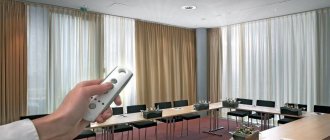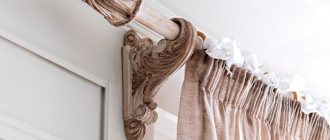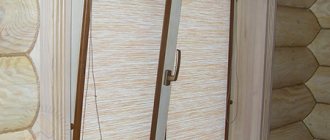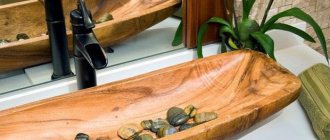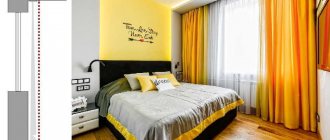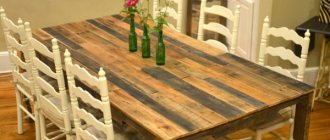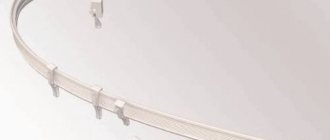An indispensable accessory in any residential interior are curtains, which help create a special comfortable atmosphere and a stylish look. When decorating an interior in a particular style, it is important to successfully select not only the curtains themselves, but also the curtain rods for them. One of the interesting, attractive and convenient options is string curtain rods, which effectively complement such modern styles as hi-tech and minimalism. Buy ready-made products or make them yourself – it’s up to you!
The main thing:
Simplicity, elegance and practicality
Looking at the spectacular string curtain rods in the photo, you can see how elegant and simple they are. Another important quality they have is practicality.
This type of curtain rod is ideal for light and medium weight curtains in a wide variety of rooms. In this regard, the popularity of such products is very high. As with other curtain rod options, there are two mounting options - wall and ceiling.
An important advantage of this type of cornice is its simple design. The most important element here is a string, sometimes there can be two or three. It is only a few millimeters in diameter. As for the length, it can vary, and sometimes exceeds three meters. To protect such a cornice from deformation that may occur over time, it is equipped with a special middle bracket. However, this condition is mandatory only for those string cornices whose length is 3 m or more.
Due to its practicality and elegant simplicity, the ceiling string curtain rod is very popular. These products are presented in a large assortment at Leroy Merlin. Here you can easily choose the most suitable option for any room - living room, bedroom, kitchen, children's room, home office and others. Thanks to their special design, string cornices are used in the arrangement of balconies and niches, giving them a unique look, visual lightness and airiness.
String curtain rods and their design features
A special type of cornice, similar to a stretched string, is becoming increasingly popular due to its ability to be used in almost any room.
This type is suitable for string curtains used where it is necessary to emphasize the beauty and texture of a material, such as silk, taffeta, organza and others. The string type can be a godsend for small rooms with low ceilings. Of course, modern curtain rods, including string ones, compare favorably with their predecessors with a variety of decorative finishes and originality. In this case, both wall and ceiling mounting can be used. String curtains are suitable for decorating a living room or loggia.
What do string-type cornices go best with?
Due to their design and characteristic features, string curtain rods are an ideal solution for curtains made from the lightest fabrics, such as silk, organza, chiffon and tulle. Using special brackets, a durable steel string can be attached to the ceiling or to the wall, depending on your preferences and the goals you are pursuing. Keep in mind that if you hang heavy and fairly massive curtains on such a curtain rod, over time it may begin to sag, so it is better to look for other options for them. And such a solution will not look the best.
String cornices are in perfect harmony with curtains made from any light, translucent curtains. It seems as if they are hanging in the air, since the string itself is practically invisible. In order to hang curtains beautifully, use convenient hooks or clips. They are presented in different colors - silver, gold and bronze, which allows you to choose the option that will harmonize with the overall style of the interior.
How to use it correctly
In order for the curtain rod in the form of a string to look attractive and last as long as possible, it is important to take into account some rules for the operation of this stylish product.
How to properly hang a string curtain rod is a question that interests everyone who comes across this accessory for the first time. The main task at this stage is to do everything as reliably as possible in order to prevent unwanted sagging.
Before you pull the string curtain rod, you should make the most accurate markings on the ceiling or wall, depending on where you plan to attach it. Then you need to perform several sequential steps:
- Mark with a simple pencil the places for attaching the brackets.
- Make holes in the marked places using a puncher or drill.
- Secure each bracket with strong and durable dowels.
- Pull the steel string through the special holes in the fasteners in both directions and secure it as firmly as possible.
- At the end of the process, you should select the optimal level of string tension - this can be easily done by rotating the bolt.
- Now all that remains is to hang the curtain, and then carefully trim off the excess pieces of string.
As you can see, installing a string cornice is not a difficult task, but you still need to approach each stage responsibly.
In order for this accessory to serve for a long time and reliably, it is important to know not only how to tighten it, but also how to use it correctly. So remember a few important points:
- If you decide to hang curtains that have significant weight, the metal string will inevitably sag after some time.
- To hang curtains and tulle at the same time, you need to pull this curtain rod twice.
- The string ceiling cornice can be mounted on any type of surface, except suspended ceilings.
- If this product is made not of stainless steel, but of another alloy, it is necessary to ensure optimal temperature and humidity conditions in the room - this will prevent corrosion.
Knowledge of how to tension a string in a cornice, combined with proper operation, is a guarantee of reliable service of this product.
The best manufacturers of string-type curtain rods
Currently, the production of string cornices, well known since the 60s of the last century, is established in many parts of the world. The best examples of ceiling cornices are offered by Belgium, as well as some other producing countries - in particular, Germany, Russia, Switzerland and Italy. By purchasing such products, you can be absolutely confident in their high quality and reliability. A wide selection of the best models of string curtain rods made in Belgium and other producing countries is presented in Leroy Merlin showrooms. By visiting one of them, you can easily select the best option in terms of length, type of brackets, color and other parameters. String-type curtain rods made in Belgium are distinguished not only by high quality and stylish appearance, but also by ease of installation, and therefore are very popular.
When choosing a string cornice, pay attention to the company and country of manufacture, the strength and reliability of the material, the availability of quality certificates and other points.
How to make a cornice yourself?
If you are not interested in any of the items on sale or you are not satisfied with the country of origin, it will be useful for you to find out how to independently manufacture and install this product. Looking at the photo, you can easily understand how this process occurs.
In fact, making a string cornice with your own hands is not at all difficult, especially if we are talking about a closed structure mounted directly to the wall. For this you will need:
- wooden plank;
- durable metal wire;
- steel corners as brackets;
- steel bolts.
The production process is as follows:
- Bolts with holes made in them should be installed in the holes of the corner brackets.
- Stretch the wire two or three times, depending on the type of curtains.
- By tightening the bolts, adjust the tension level of the wire string.
To hang curtains, you can use the simplest hooks. As you can see, it’s not difficult to make an element with your own hands that, in combination with well-chosen curtains, will effectively decorate the interior.
The popularity of string cornices is due to many factors - low cost, practicality and convenience, as well as aesthetic appearance. There is a wide selection of stylish elements to decorate them. In addition, you can make a ceiling or wall cornice of this type with your own hands. This product, combined with attractive lightweight curtains, will add a touch of elegance to any room.
Curtain rods, consisting of special holders and a cable stretched between them, have retained a certain niche in the consumer market for many years. They are traditionally used in cases where a window opening needs to be curtained with a cloth made of light and transparent materials.
With the revival of fashion for tulle, chiffon, as well as the emergence of new types of fabrics for curtains, such as jacquard, light cotton, satin made of artificial fibers, the string cornice received its second life.
The string option has practically no alternative in cases where the wall near the window opening is not wide enough to accommodate the rod. With this more compact and lightweight design, you can design small or non-standard windows.
DIY string cornice
A simple mechanism allows you to make a string cornice yourself.
It is preferable to mount the structure to the wall using the end method and make closed curtains.
We will need:
- Steel corners - these will serve as brackets.
- Reliable strong wire, you can use copper or stainless steel - they will serve us instead of a string.
- The bolts will serve as a cable clamp. Or you can replace it with a threaded hook.
- Materials for fastening corners to the wall.
In the metal corners, on one side, we drill two holes for fastening to the wall, then for the bolt itself. Cut off the cap and make a hole for the wire. We attach the corners to the previously prepared markings on the wall, screw in a bolt (or hook) on one side. We make hooks on the wire, having previously measured the length of the thread.
We put both ends of the wire on the brackets, with one already located in the corner, and the second not yet secured. Then we screw the second bolt into our holder, thereby tensioning the string.
Features of string cornices
The range of string cornices on the market is expanding every day. Minimalist models can practically merge with the walls and frames, or, through original brackets, add a stylish touch that is in tune with the overall concept of the interior.
Non-bulky holders and strings can also be easily disguised with facade decor. The photo shows curtains with string cornices in various styles.
Designers have chosen this type of curtain rods not only because of their ease of installation and compactness. Using string for hanging curtains may be the only possible option, for example? in case it is necessary? so that the edge of the curtain is closely adjacent to the wall, or when the window occupies the entire width of the wall.
Ceiling string cornices allow you to solve almost any non-standard design problem. For example, using ceiling structures you can create internal partitions in a room. Such cornices are also indispensable for curtaining windows in attics with slanted ceilings.
Proper interior design does not require the use of different types of cornices, so the string option, due to its versatility, turns out to be preferable.
On the market you can also find ready-made combined models of double-row curtain rods with a rod for heavy curtains and a cable for tulle and other light fabrics.
The string in the traditional version of the cornice is a steel cable with a special coating. For color variations, chrome plating, copper or brass plating is used.
For rooms with high humidity, you need to choose cables with an anti-corrosion coating. In addition to metal, wood, ceramics, glass and polymers can be used in the external design of brackets.
High-quality materials, options with two or three tension cables allow you to use string curtain rods with almost any curtain fabric. To avoid the main drawback - sagging, it is necessary to correctly calculate the weight of the curtains and install intermediate brackets.
The installation of such additional holders is strictly recommended if the opening width is more than 3 meters. They can also be provided in smaller openings: despite the fact that the additional bracket limits the movement of the curtains, such insurance against sagging will allow you to enjoy perfectly smooth sliding of the curtain, which other types of curtain rods cannot provide.
Another advantage of string curtain rods is the ability to temporarily dismantle the curtain: the cable along with the curtain can be easily removed and, unlike removable pipe structures, does not take up much space. This method of curtaining is convenient to use on open balconies, loggias, gazebos, etc.
Features of operation of string cornices
The string cornice is a very unpretentious element of the interior
However, in order for it to fully perform all the necessary functions, you need to know some of the features of its operation.
- String cornice is designed for light and medium fabrics. That is, chiffon, tulle, organza, veil, muslin - this type of curtain rod is perfect for all these curtains. As a last resort, for lightweight jacquard, artificial satin, light cotton. This type of curtain rods is not intended for heavy teak and tapestry fabrics. The string will simply sag, unable to cope with the load.
- If you want to hang the classic version of curtains, that is, daytime tulle and thicker curtains, then you will have to pull the string in two rows, and if you decide to add a lambrequin, you will need three rows of string.
- Installation of cornices is possible on almost all surfaces. The exception is suspended ceilings; a string cornice cannot be attached to them. There is also considerable controversy regarding the ability to attach string cornice to plasterboard ceilings or walls. Some experts say that this should never be done, while other sources consider such fastening acceptable. Everything will depend on what kind of curtains you plan to hang on the cornice. If you decide to take a risk and strengthen the string on a plasterboard ceiling, then choose the lightest curtains. Even average fabric weight can be critical to your design.
- From a design point of view, string cornices look most advantageous on rectangular windows or in the design of wide window openings.
- When choosing a cornice, pay attention to the fact that now there are options on the market with different tension systems. Therefore, before purchasing a curtain rod, the design of which is not completely clear to you, ask the seller to explain to you how to properly hang such a curtain rod and adjust the string.
- The string cornice is made of metal and can therefore be subject to corrosion. If you plan to install such a cornice in a room with unstable temperatures or high humidity, then take care to purchase a cornice with a special coating. For ordinary, ventilated and heated premises, this requirement is not mandatory.
Main stages of installation
Design. Before hanging the jet curtain rod, you need to double-check the load calculations and the resulting number and location of brackets. Their compactness gives greater freedom for improvisation, but do not forget about the necessary distances from the walls and ceiling. Only a well-thought-out design can ensure trouble-free operation.
Measurements and markings. This is the most critical stage of installation. The slightest misalignment can create problems when the curtains move, cause sagging, as well as rapid wear of the strings and fasteners.
Attaching the holders. The drilling method and fastenings must be selected taking into account the physical characteristics of the walls and ceiling. The bases of the brackets are assembled using threaded connections.
String tension. Typically, the cable is tensioned using a mechanical rotation bolt or other bracket element. After the curtains are already hung, additional adjustments will be needed.
The brackets on the market differ not only in the number of strings they can carry, but also in the different tensioning mechanisms. When purchasing a particular model, you must thoroughly familiarize yourself with the method of securing and tensioning the string. The configuration features of the holders are also important. Some models are universal, others are designed only for ceiling or wall mounting of cornices
The curtain fabric is secured to the string using clips or hooks; you can also use newfangled ribbons with magnets.
Photo of string cornice
Today, string curtains, which are attached to a special type of cornice in the form of a stretched string, are gaining wide popularity. They can be used to decorate any living rooms, loggias and balconies, kitchens, niches. String curtains are especially good when it is necessary to highlight the grace and beauty of the material used: silk, taffeta, organza and others. In the photo we see that the string as a curtain rod is ideal for low, compact rooms. It can be fastened to the ceiling or wall, as well as in special niches.
Advantages of string cornice
Why is such a simple and, frankly, uncomplicated version of the cornice still popular, and is it not going to lose its position? The thing is that it has a number of significant advantages over more technologically advanced options.
- The string cornice is compact in size. Having bought it, you will carry it home in an ordinary woman’s handbag, and you will need a minimum of space to place and attach it.
- This cornice can be easily hidden behind curtains and is almost invisible in the interior. This gives special lightness and weightlessness to the entire fastening system. It seems as if the curtain itself is floating in the air.
- If you want to place some emphasis on this element of the interior, you can purchase it in gold or silver. It looks very decent and will decorate your room.
- The string cornice is universal. It can be mounted in the bedroom or living room, kitchen or nursery. You can hang not only a window curtain on it, but also a space divider or a curtain in the bathroom. Such a cornice can be used equally successfully for an apartment, house, cottage or garage.
- Price is one of the main trump cards of this method of attaching curtains. The cost of a string cornice starts from 100 rubles. Such democracy greatly contributes to popularity among the population.
So the string cornice continues to live and find application in the most modern designer interiors. Try it and you will appreciate the elegant simplicity of its use.
Today, string curtains, which are attached to a special type of cornice in the form of a stretched string, are gaining wide popularity. They can be used to decorate any living rooms, loggias and balconies, kitchens, niches. String curtains are especially good when it is necessary to highlight the grace and beauty of the material used: silk, taffeta, organza and others. In the photo we see that the string as a curtain rod is ideal for low, compact rooms. It can be fastened to the ceiling or wall, as well as in special niches.
Design features
In the photo you won’t be able to see all the features of string curtain rods, but there are quite a few of them. It is necessary to focus on the following points:
- a thin but very strong steel string serves as the basis for the cornice;
- to attach the string to the ceiling or wall, special brackets resembling staples are used;
- the length of such a cornice can reach five meters, and with the help of brackets it can be secured in several rows;
- special clips or hooks are used to attach curtains to the string;
- At first glance, it may seem that the string cornice has a simple design, but it can look very elegant if it is covered, for example, with gilding or imitating antique brass.
How to attach a cornice
Hanging string curtains with your own hands is not at all difficult. Attaching the cornice will not take much time; this is always done according to a simple algorithm:
- Make a mark on the ceiling or wall where the cornice should be. Using a pencil, mark the mounting locations for the brackets;
- make holes with a drill or hammer drill;
- use dowels to secure the brackets;
- pull the string through the holes in the fasteners in both directions and secure firmly;
- Now you can tighten the string to the extent that seems optimal to you. To do this, simply rotate the bolt;
- hang the curtain and trim the remaining string.
How to firmly attach a string cornice
The string cornice has a fairly simple design. It consists of support and intermediate brackets, cable and tensioning mechanisms. Usually the package also includes hooks and mounting hardware.
It is quite possible to install a string curtain rod with your own hands. The main stages of this work are clearly described in the installation diagram. It may have some differences depending on the design features of a particular mechanism.
Open and closed string cornice fastening system.
But its general points are universal.
- First, the exact location of the cornice is determined. The fixing points of the brackets are marked on a section of the wall or ceiling. It is necessary to provide for the fastening of both support and intermediate brackets. The distance between the latter is usually 30-50 cm.
- Using a drill or hammer drill, holes are drilled. Drills are selected depending on the building material of the walls or ceiling. The string can be attached to absolutely any ceiling. With some skill, it can even be mounted on a suspended ceiling.
- Dowels are inserted into the holes. Mounting screws are screwed into them. They need to be clamped until the support brackets firmly adhere to the wall or ceiling surface.
- Next, the bases of the brackets are assembled. Then you need to thread a string through the existing holes in the fastening tip. One end of it is fixed in the sleeve. A tip is placed on the assembled base.
- Intermediate brackets are installed. A string is pulled through the grooves of the support and intermediate brackets. Its free end is fixed by a sleeve located in the second support bracket. The tension is set using brackets. To do this, tighten the tension bolts until the string is completely straightened.
- The remaining part of the string is cut off or carefully hidden under the tip. If the string is not loose, you can attach curtains to it. It is necessary to take into account 2 more points. The outer curtain clips (rings) should be located outside the support brackets. Then the curtains will be evenly distributed along the entire length of the structure. Before completing the overall assembly of the frame, you need to install the hooks and plugs.
- From time to time you will have to use tension bolts. The weight of the curtains may cause the string to sag. Then it is necessary to restore the initial tension by tightening the bolts.
Advantages and rules of operation
If you look at the photo of string curtains, you will have no doubt that this solution looks at least elegant. In order for a string cornice to adequately perform its intended functions, you should have an understanding of the features of its operation:
- It is advisable to hang only light curtains made of tulle, chiffon, organza, etc. on a string. If you hang thick and heavy curtains, the string will simply sag over time;
- the string cornice must be pulled in at least two rows if you want to hang curtains along with tulle. If you want to decorate the composition with a lambrequin, you will need a cornice in three rows;
- the cornice can be mounted on almost any type of surface except suspended ceilings;
- from a design point of view, string curtains are especially good on rectangular windows and wide window openings;
- To avoid corrosion, it is better to install metal string cornices in rooms with stable temperatures and normal humidity.
So, we see that string curtains are a fairly simple and even uncomplicated option for window design, but it is this one that has gained stunning popularity today. The thing is that this type of cornice has a number of advantages. Firstly, it is very compact in size, and if you hide it behind a curtain, it will be completely invisible. In the photo, the curtains look like they are made from the ceiling itself, which looks very impressive.
Secondly, the string can just as well become an unusual accent if it is made in unusual variations, for example, from gold-plated or silver metal. Thirdly, string curtains, as we see in the photo examples, are a universal option for decorating any room, made in any style and direction.
We do it ourselves
You can quickly make a convenient and simple string cornice even with your own hands. It is preferable to make the structure of such a cornice closed and install it directly to the wall. To create a decorative strip, use a wooden panel, which will also serve as the basis for the cornice. Instead of a string, use strong wire, and steel corners as brackets. With their help you can hang the curtain rod and stretch the strings.
Take the bolts with pre-drilled holes and install them in the holes of the brackets. Pull the wire in two or three rows. The tension can be adjusted by tightening the bolts. Hang the curtains on the simplest hooks.
So, string curtains are a fairly practical option for window decoration. Its simple elegance makes it a win-win solution for decorating any room.
How wonderful it is to return to your warm and cozy home after a hard day at work. There, where everything is yours down to the last detail: sweet and dear. The uniqueness, charm, comfort and warmth of each home is given by its design, including textiles. Tapestries on the walls, covers on the sofas, tablecloths on the table, curtains on the windows - everything matters. All this can be created with your own hands. All you need is desire and a little patience. And no matter what the house is, curtains have always been and remain an indispensable accessory in any living room. But when decorating the interior in one style or another, it is very important to choose the right curtains, as well as curtain rods for them. It deserves special attention, as it is gaining more and more popularity.
How to strengthen a string cornice correctly
Before purchasing, it is important to ensure the integrity of the set - the moving parts must be in working order, the tightening screw must have good movement, hooks or decorative fasteners must slide smoothly, the cable must have a surface without metal burrs. The price of string curtain rods should not affect the quality. If the kit is satisfactory, proceed with its installation.
Fastening
The tools you will need are a drill with diamond drills if the wall is monolithic. The steps are as follows:
- Places for attaching curtain strings to brackets are marked. To do this, the desired string length is marked on the wall. The dots are marked with a pencil.
- Holes are drilled in the marks and the holders are fixed with dowels.
- The string is unraveled, stopping the torsion, and only then mounted in the holes of the brackets.
- One end passes through a tension bolt with a groove and is secured at the opposite end of the cornice.
- Now you need to tighten the curtain string by rotating the bolt until it reaches the desired elasticity. Subsequently, when the curtain is already hung, the tension is adjusted again.
The fixed ends of the string should not be cut off at all - they are twisted into neat turns and left at the ends for future fixation. If you do not make a reserve, then the string will subsequently fall out of the groove in the bolt.
To put the curtains on the strings, decorative hooks are immediately attached. The fabric is stitched with textile tape, forming loops and folds.
Homemade string
Those who like to work with their hands will appreciate the design for string curtains, made independently. The principle of operation and fastening is the same. The materials used are either the cable itself, or copper wire. Steel angles and bolts with pre-drilled holes in the stud will come in handy. Their number is equal to the desired layers of curtains.
A simple installation of a string cornice consists of inserting bolts with fixed wire into the threaded holes of improvised brackets and then tightening them. Of course, if you use unpresentable parts from your own garage for work, you can hardly expect beauty. Therefore, it is worth purchasing decorative elements in advance to create a better look. All that remains is to strengthen the hooks or clips and the curtain can be hung.
WATCH VIDEO INSTRUCTIONS
Having considered the advantages and disadvantages of a string cornice and independent work, you can make a choice in its favor or refuse, believing that the disadvantages will greatly affect the chosen version of the canvas.
How wonderful it is to return to your warm and cozy home after a hard day at work. There, where everything is yours down to the last detail: sweet and dear. The uniqueness, charm, comfort and warmth of each home is given by its design, including textiles. Tapestries on the walls, covers on the sofas, tablecloths on the table, curtains on the windows - everything matters. All this can be created with your own hands. All you need is desire and a little patience. And no matter what the house is, curtains have always been and remain an indispensable accessory in any living room. But when decorating the interior in one style or another, it is very important to choose the right curtains, as well as curtain rods for them. It deserves special attention, as it is gaining more and more popularity.
String cornice design
The main element of this curtain rod is a stretched curtain string made of very strong steel. It is attached using special devices - brackets.
Holders can be of different shapes, sizes and colors. They are chosen in the style of the overall interior of the room. They are mounted on the ceiling or wall.
- five meters. The cornice, if necessary, is mounted in several rows on brackets. The choice of the number of rows of cornice depends on the textile design of the window. A separate string is planned for each element of curtain decoration: lambrequin, curtains, tulle. The strings for ceiling curtains are made of steel, so the string cornice is not only the most elegant, but also quite durable.
In order to secure the curtain fabric to the string, use special hooks, clips or clips.
Hooks. This is a classic element of any cornice.
Hooks require a special braid with loops on the curtain.
Clips. These are two magnets connected to each other by a cable.
The clips have captivated users with their lightness and ease of use. Throwing the cable of the clip over the string of the cornice is very simple. In addition to being easy to use, the clips do not require additional curtain tapes with loops or any other devices. This type of fastening does not injure the curtain fabric, which is undoubtedly its important advantage.
In operation, it looks like this:
But clips also have their drawbacks. They are simple, light, beautiful in the interior for light fabrics and veils, but not desirable for use with heavy curtains. There is a risk that they simply won’t be able to keep them.
Clips are an excellent element of a string curtain rod, which are very easy to use, do not require curtain tape, and are capable of holding thicker curtains than clips.
The only thing worth paying attention to is the fact that the “teeth” of the clamp can injure the curtain fabric.
In operation, it looks like this:
The design is not complicated. Variations of use are different. Depending on the curtain design of the window, you can choose suitable fastenings, both curtains and the string itself. All this speaks to the versatility of the string cornice. You don’t need to be a virtuoso to make this cornice invisible to the eye, and to make the window design as gentle and airy as possible.
Features of string structures
First, it should be said that such products are widely used. They are used to decorate residential premises, balconies and loggias. The devices are attached to the wall or ceiling. String curtain rods have a simple design:
- The basis is a thin steel cable
- this is a load-bearing element, the length of which varies within several meters. If the length is 3-5 m, an intermediate holder is installed in the center of the window. This is done so that the cable does not sag under the weight of the curtains; - small brackets, similar to staples, - they are made of durable metal. Decorative details are made in different styles: classic, baroque, country and empire
. The brackets can have the appearance of a blooming flower, a geometric figure, striking arrows, or a tripod; - special clips or hooks - such elements are used for attaching curtains. For light tulle fabrics, clip-on clothespins are more suitable. If you use curtains with hidden loops or braid, you need to choose hooks;
- tips - metal, wood, glass, plastic and ceramics are used to make components. The imagination of designers is not limited by any boundaries. For this reason, in many models the tips have a non-standard appearance;
- bushings - with their help, the tension of the steel cable is adjusted
.
Curtain string can be brass, copper, chrome or bronze coated. The color must match the style of the other elements. Then a complete structure will be created in which all the details resonate with each other.
The string cornice can be one-, two-, or three-row. The specific choice depends on your personal preferences and overall concept
interior For example, if only tulle will be hung on the product, the best option is a single-row device.
Having looked through the WESTWING shopping club catalog, you will be convinced that we have an excellent choice. Our main principle is cooperation with leading manufacturers, so the number of subscribers increases every year. If you want to take advantage of profitable promotions and take part in sales, join us! On the pages of the web resource you can easily find a string cornice that perfectly matches the interior!
It is impossible not to mention that we offer a variety of types
designs for fastening curtains:
- Wooden cornices are convenient and functional devices made from environmentally friendly material. They are matched to the color of parquet, doors and furniture. The most popular types of wood are: juniper, yew, mahogany and ebony.
- Plastic curtain rods - branded manufacturers use materials that have good characteristics: high hygiene, environmental safety, moisture resistance
. - Metal cornices are structures that have a number of significant advantages. These include reliability, durability and long service life. The color of metal products can be different: chrome, gold or silver.
- Designs for Japanese curtains are specific devices used for attaching curtains to windows and for zoning rooms. For convenience, the Japanese cornice is equipped with an electric drive.
Installation of string curtain rods
Before installing a string curtain rod in your room, it is very important not to skip the very first stage - purchasing the curtain rod itself. During the purchasing process you need to check:
- are all the moving elements of the cornice in working order;
- does the tightening screw work well?
- the cable, decorative clips or hooks must be free of metal burrs and move smoothly.
If you are satisfied with the quality of the cornice, then you can begin installation.
During operation, curtains may sag. Don't be afraid of this. The string can always be tightened.
How to strengthen a string cornice correctly
Before purchasing, it is important to ensure the integrity of the set - the moving parts must be in working order, the tightening screw must have good movement, hooks or decorative fasteners must slide smoothly, the cable must have a surface without metal burrs. The price of string curtain rods should not affect the quality. If the kit is satisfactory, proceed with its installation.
The fixed ends of the string should not be cut off at all - they are twisted into neat turns and left at the ends for future fixation. If you do not make a reserve, then the string will subsequently fall out of the groove in the bolt.
To put the curtains on the strings, they immediately hook them. The fabric is stitched with textile tape, forming loops and folds.
Homemade string
Those who like to work with their hands will appreciate the design for string curtains, made independently. The principle of operation and fastening is the same. The materials used are either the cable itself, or copper wire. Steel angles and bolts with pre-drilled holes in the stud will come in handy. Their number is equal to the desired layers of curtains.
A simple installation of a string cornice consists of inserting bolts with fixed wire into the threaded holes of improvised brackets and then tightening them. Of course, if you use unpresentable parts from your own garage for work, you can hardly expect beauty. Therefore, it is worth purchasing decorative elements in advance to create a better look. All that remains is to strengthen the hooks or clips and the curtain can be hung.
httpv://youtu.be/V_8JdZrpex8
Having considered the advantages and disadvantages of a string cornice and independent work, you can make a choice in its favor or refuse, believing that the disadvantages will greatly affect the chosen version of the canvas.
Operating rules
String – is universal among cornices. An uneven ceiling or a crooked stele will not interfere with it. A modern string cornice is almost invisible, and its fittings are exquisite. A curtain on such a curtain rod will ideally support a composition with blinds or a Roman blind, which will make it universal in any room. This is a wonderful decorative element to create coziness in every room.
But, nevertheless, it is important to remember that it is better to install a string cornice in a room that is ventilated. Then the elements of the cornice will not succumb to corrosion.
You should not use a curtain rod for very heavy curtains. The cable may sag.
The string curtain rod is perfect for light jacquard fabrics, voiles, satin or cotton. It creates lightness and airiness in the interior. Due to its invisibility, there is no feeling of bulkiness on the windows. It is justified in small rooms, expanding them and visually raising the ceilings.
In a room where there is a need to limit the flow of sunlight, you can easily use two strings and decorate the window with a veil and curtains. The biggest advantage is the ease of movement of the curtains. In this type of cornice, the hooks never catch each other, and one strip of fabric does not prevent the other from sliding.
If the string cornice is installed correctly, then during operation it will not cause inconvenience or disappointment.
Knowing all the advantages and disadvantages, you can make a choice in favor of a string cornice, or refuse it. But, if the design solution has found support among the materials used, and the shortcomings of the cornice will not affect the user’s needs in any way, then it will become an excellent aesthetic center of any room.
High-tech, minimalism, airy romance - there are many interior solutions for which it makes sense to choose a string type of curtain rod. A string cornice is perhaps the simplest and most cost-effective design for attaching tulle and curtains. The sparkling metal of the string and brackets can be a decorative element in itself, but if you wish, you can hide it with an elegant baguette.
What opportunities do string cornices provide designers with? This photo selection contains examples of string curtains that elegantly fit into interiors of various styles.
Features of string cornice
Structurally, the string cornice is a tightly stretched metal cable of small diameter (several millimeters). Such a cornice may have not one, but two or three strings.
If the window opening is wide, and a string more than three meters long is required: under the influence of gravity, after some time it will begin to bend downwards. And the point here is not strength, so simply increasing the diameter cannot be done. To solve the problem, an additional bracket is installed in the middle of the string. True, there is some limitation: each curtain panel can only be moved on its own side, from the side to the central bracket. This point should be taken into account when creating a curtain composition. However, there are many options for window decoration where the curtains do not need to be moved: for example, a string cornice is perfect for cascading streams of muslin thread.
One more possible problem that may arise during the operation of a string cornice should be taken into account - corrosion. This problem occurs in rooms with a humid microclimate. But, since many manufacturers now coat the strings with an anti-corrosion coating, such curtain rods can even be used in bathrooms.
By the way, in the bathroom, a curtain rod is one of the most optimal solutions when zoning space. If you decide to fence off the bathtub with a curtain, it is better to stretch a metal string with an anti-corrosion coating than twine or fishing line: it is both stronger and looks much more aesthetically pleasing.
Bracket as a decorative element
Despite its external simplicity and minimalism, a string cornice may well play not only a functional, but also an aesthetic role in the interior. A metal string, complemented with sparkling hooks or clips, will be a stylish addition to a high-tech setting. And if you choose transparent plastic clips, the tulle or muslin will simply float in the air, creating a feeling of sophisticated romance in the bedroom or living room.
Original brackets add impressiveness to the string cornices. Their geometry can be non-standard, sometimes simply fantastic. Often, brackets are styled to look like floral elements or vintage details.
If you want to create a retro atmosphere in the room, but don’t want to weigh it down with massive curtain rods, there is an interesting alternative! You can choose a string cornice with exquisite brackets and a finish in antique brass or dark silver, aged bronze or patinated gold. This weightless luxury will be effectively combined with expensive translucent fabrics.
Well, if you decide to hide the string cornice, choose the baguette option. “Baguettes” are cornices, the mechanism of which is hidden under decorative strips.
